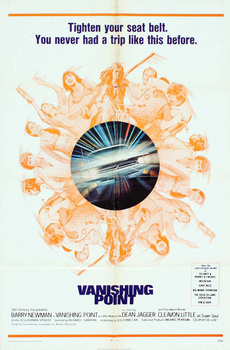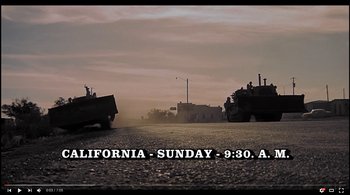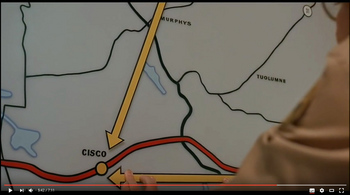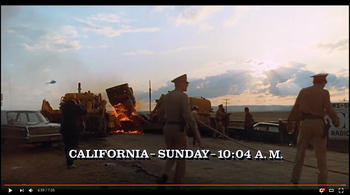An Expression Derived From Cisco − “Vanishing Point”, Part 1 [Column_Cisco Township]
Our model and/or layout are pieces of work driven by the phantasm. But the phantasm and the actuality don’t coincide with each other: there is a difference between the two. I think the vitals of our hobby is hidden between the two.
Town of Cisco attracts many to this day in spite of/because of its desolation. The desolation may cause phantasms in callers’ minds. Creators who visited Cisco through the ages produced pieces of work driven by their phantasms. Then, in turn, the pieces of works draw another caller (like me) to Cisco.
But, as always, the phantasm and the actuality aren’t the same here at Cisco. Here, I analyze how the creators remixed actual Cisco to produce their piece of works, to extract the vitals of their creation.
 : Vanishing Point poster
: Vanishing Point poster
Vanishing Point (1971)
directed by Richard C. Sarafian
written by Guillermo Cain (Guillermo Cabrera Infante)
director of photography, John A. Alonzo
Vanishing Point is a road movie tracking a car delivery driver Kowalski from Denver west. The movie was filmed in June 1970 in the states of Colorado, Utah, Nevada and California[1, 2]. The opening and ending scenes of the movie were shot here at Cisco, Utah.
Ethel’s Cafe appears in the opening scene behind the title. As the camera pans, deserted Cisco Motel, Mercantile, McCoy’s, Ruth’s and Capansky’s appear in turn after that. By then actual Cisco residents seem also appears in the following cuts. But no one is listed in the end credit roll. Moreover, the name of the place is credited only as CALIFORNIA.
Near the ending scene, the name of the place is revealed as CISCO. It sure is the actual name. It was placed not in Utah but in California; the name of the place is actual but also virtual.
In the ending scene, Kowalski slams his car into bulldozers set on the highway in front of Ethel’s Cafe. In the scene, the car is facing west. But it actually is facing east. The last scene is credited 10:04 A.M. But, considering the sun behind the crashed car, it actually is early in the evening. Accordingly, the opening and ending scenes are the virtual images; as if to say reflected images of actual Cisco. And the name of the place is the sole focal point between the virtual and the actual.
[1] Jun. 11, 1970 Times-Independent;
[2] Jun. 25, 1970 Times-Independent;



わたしたちのつくる模型やレイアウトには幻像に駆られたものが多い。ここで幻像とは過去像といってもいいかもしれない。筆者の、今やゴーストタウンと化しているシスコの町のストラクチャーなどその最たるものだ。幻像だから実際とは一致しない。わたしたちの趣味における核心はこの幻像と実際の狭間にこそ隠されている、と筆者は考えている。
シスコの町はゴーストタウンと化しているにもかかわらず/化しているからこそ、多くのひとを集めてきた。その寂寥感が訪問者に幻像をもたらすのだろう。ここを訪れたクリエーターの多くが、その幻像に駆られ作品を遺してきた。その作品が、また、わたしのような人々をシスコに呼ぶのだ。
しかし、冒頭で述べたように、ここシスコでも幻像と実際とは一致しない。クリエーターのシスコにインスパイアされた作品における幻像と実際の差を分析することにより、彼らによる創造の核心について探ってみたい。
バニシング・ポイント(1971)
監督:リチャード・C・サラフィアン
撮影:ジョン・A・アロンゾ
脚本:ギレルモ・ケイン
「バニシング・ポイント」は、陸送屋コワルスキーのコロラド州からカリフォルニア州に至る行程を追うロード・ムービーである。ロケは、1970年初夏にコロラド州、ユタ州、ネバダ州、カリフォルニア州において行われた。シスコの町はオープニングおよびラストのシーンに登場する。
オープニングでは、カメラがパンするにしたがって、Ethel’s CafeからCapansky’sに至る道路沿いの建物が順に映し出される。続くカットでは住人と思われるひとびとも映るが、エンドロールに名前が記されることはない。町の名前も「CALIFORNIA」とのみ記され明かされず、映画の後半でようやく「CISCO」だと分かる。しかし、それはユタ州ではなくカリフォルニア州にあることになっている。ラスト・シーンでも字幕は「CALIFORNIA」のままだ。
ラスト・シーンにおいて東から西に向け走っているはずのコワルスキーの車は、実際の撮影現場では東に向かっている。字幕には日曜日の朝となっているが、太陽の位置から推測して、実際の撮影は夕刻である。このように、この映画におけるシスコのシーンは鏡像とでもいうべき裏返しの虚像である。町の名前が、虚実の焦点になっているのだ。
Town of Cisco attracts many to this day in spite of/because of its desolation. The desolation may cause phantasms in callers’ minds. Creators who visited Cisco through the ages produced pieces of work driven by their phantasms. Then, in turn, the pieces of works draw another caller (like me) to Cisco.
But, as always, the phantasm and the actuality aren’t the same here at Cisco. Here, I analyze how the creators remixed actual Cisco to produce their piece of works, to extract the vitals of their creation.
 : Vanishing Point poster
: Vanishing Point posterVanishing Point (1971)
directed by Richard C. Sarafian
written by Guillermo Cain (Guillermo Cabrera Infante)
director of photography, John A. Alonzo
Vanishing Point is a road movie tracking a car delivery driver Kowalski from Denver west. The movie was filmed in June 1970 in the states of Colorado, Utah, Nevada and California[1, 2]. The opening and ending scenes of the movie were shot here at Cisco, Utah.
Ethel’s Cafe appears in the opening scene behind the title. As the camera pans, deserted Cisco Motel, Mercantile, McCoy’s, Ruth’s and Capansky’s appear in turn after that. By then actual Cisco residents seem also appears in the following cuts. But no one is listed in the end credit roll. Moreover, the name of the place is credited only as CALIFORNIA.
Near the ending scene, the name of the place is revealed as CISCO. It sure is the actual name. It was placed not in Utah but in California; the name of the place is actual but also virtual.
In the ending scene, Kowalski slams his car into bulldozers set on the highway in front of Ethel’s Cafe. In the scene, the car is facing west. But it actually is facing east. The last scene is credited 10:04 A.M. But, considering the sun behind the crashed car, it actually is early in the evening. Accordingly, the opening and ending scenes are the virtual images; as if to say reflected images of actual Cisco. And the name of the place is the sole focal point between the virtual and the actual.
[1] Jun. 11, 1970 Times-Independent;
[2] Jun. 25, 1970 Times-Independent;



わたしたちのつくる模型やレイアウトには幻像に駆られたものが多い。ここで幻像とは過去像といってもいいかもしれない。筆者の、今やゴーストタウンと化しているシスコの町のストラクチャーなどその最たるものだ。幻像だから実際とは一致しない。わたしたちの趣味における核心はこの幻像と実際の狭間にこそ隠されている、と筆者は考えている。
シスコの町はゴーストタウンと化しているにもかかわらず/化しているからこそ、多くのひとを集めてきた。その寂寥感が訪問者に幻像をもたらすのだろう。ここを訪れたクリエーターの多くが、その幻像に駆られ作品を遺してきた。その作品が、また、わたしのような人々をシスコに呼ぶのだ。
しかし、冒頭で述べたように、ここシスコでも幻像と実際とは一致しない。クリエーターのシスコにインスパイアされた作品における幻像と実際の差を分析することにより、彼らによる創造の核心について探ってみたい。
バニシング・ポイント(1971)
監督:リチャード・C・サラフィアン
撮影:ジョン・A・アロンゾ
脚本:ギレルモ・ケイン
「バニシング・ポイント」は、陸送屋コワルスキーのコロラド州からカリフォルニア州に至る行程を追うロード・ムービーである。ロケは、1970年初夏にコロラド州、ユタ州、ネバダ州、カリフォルニア州において行われた。シスコの町はオープニングおよびラストのシーンに登場する。
オープニングでは、カメラがパンするにしたがって、Ethel’s CafeからCapansky’sに至る道路沿いの建物が順に映し出される。続くカットでは住人と思われるひとびとも映るが、エンドロールに名前が記されることはない。町の名前も「CALIFORNIA」とのみ記され明かされず、映画の後半でようやく「CISCO」だと分かる。しかし、それはユタ州ではなくカリフォルニア州にあることになっている。ラスト・シーンでも字幕は「CALIFORNIA」のままだ。
ラスト・シーンにおいて東から西に向け走っているはずのコワルスキーの車は、実際の撮影現場では東に向かっている。字幕には日曜日の朝となっているが、太陽の位置から推測して、実際の撮影は夕刻である。このように、この映画におけるシスコのシーンは鏡像とでもいうべき裏返しの虚像である。町の名前が、虚実の焦点になっているのだ。
2017-07-28 09:00
コメント(0)




コメント 0